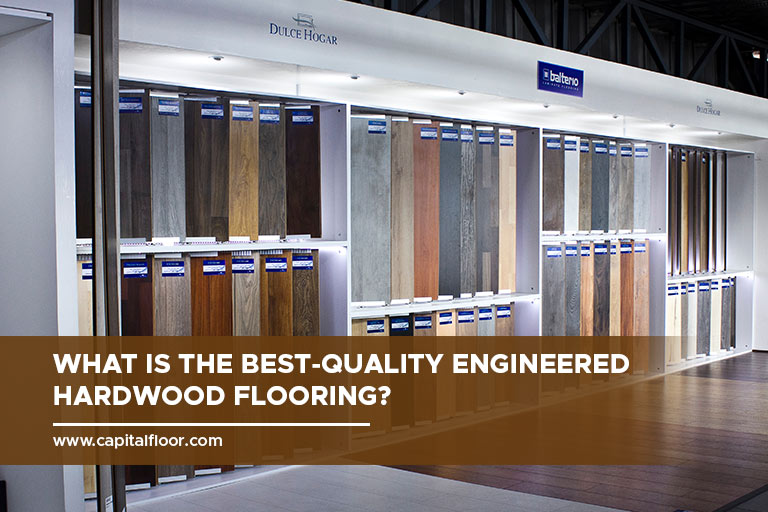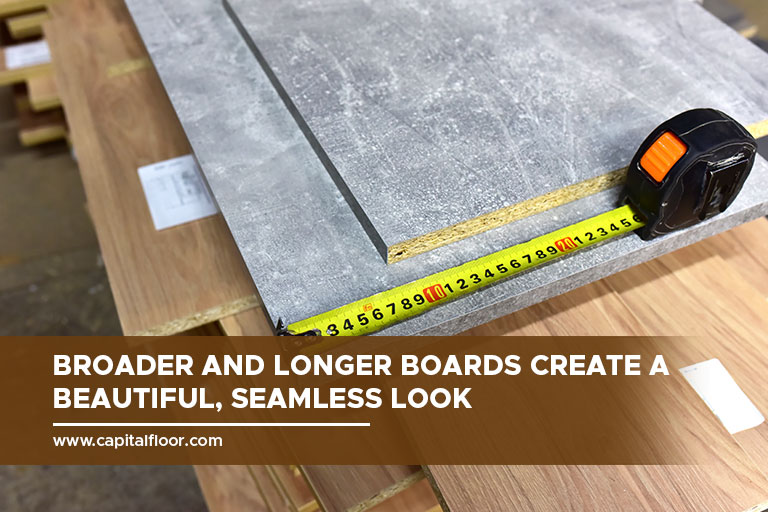Our showroom is open to the public. Please click HERE for more details.
Our showroom is open to the public. Please click HERE for more details.

When searching for a wide plank-engineered wood floor, various factors, such as cost, ease of installation, and stability, may influence your decision. Unfortunately, not all engineered flooring is created equal, and it’s essential to recognize the standards that distinguish high-quality options.
Most people desire a floor that is aesthetically pleasing, durable, and stable, performs well in their environment, has a long lifespan, and is easy to maintain. If you’re wondering “What is the best quality engineered hardwood flooring?” it’s essential to look beyond surface-level features and understand the 4 critical design elements: construction and manufacturing, dimensions, appearance, and environmental guidelines.
In doing so, you can assess the intrinsic differences between products and make an informed decision. Here are the factors that determine the best-quality engineered wood flooring:
Engineered hardwood flooring is composed of a thin top layer of wood called the veneer and multiple layers of backing known as the core. The thickness of the veneer and core may vary depending on the design and manufacturer, but this construction detail plays a significant role in the appearance, stability, and durability of the floor.
Certain criteria must be met to ensure that you select the best quality engineered hardwood flooring. This includes an overall thickness of either 5/8″ or 3/4″, a veneer thickness of 4mm, and a core thickness of either 9-ply or 11-ply. The dimensional stability of your engineered floor can be further enhanced if the manufacturer designs the board with a thicker core than the veneer layer and layers each ply of the core so that the grain runs at a 90° angle to the grain pattern of the previous ply.

Most engineered wood flooring typically has a width of 3 inches and a length of 3 feet. This can result in hundreds of boards needed to cover a 20×20 room. The standard practice in manufacturing is to focus on producing as much flooring as possible, which can compromise the quality and appearance of the product.
If you desire a wider plank floor, work with a manufacturer that offers more options, such as 6″, 8″, or 10″ widths, as well as random or uniform widths. Additionally, it would be best to look for floors with longer lengths, graded to achieve a specific average length range. Using broader and longer boards reduces the number of seams on the floor, resulting in a more beautiful and seamless appearance.
To ensure that your wide plank-engineered wood floor is aesthetically pleasing and durable, selecting the right type of veneer layer is important. There are 2 methods for creating the veneer layer: a dry-sawn face cut with a saw blade or a sliced and rotary peeled face cut with a knife blade. The former method produces the same visual appearance as a solid wood floor, with the same heartwood, grain, and character. In addition, this method allows for wider widths and longer lengths and thicker veneer layers that serve as the wear layer of the floor. This means that the floor will last longer and can be sanded multiple times.
On the other hand, engineered flooring made from sliced and rotary peeled material will only have thinner veneer layers of about 2mm, which will not last as long and may need repair or replacement sooner. Additionally, this method boils the wood before peeling, which can cause future moisture issues, resulting in floorboards that resemble plywood more than real wood floors.
When choosing a wide plank floor for a residential or commercial space, indoor air quality should not be a concern. However, since most flooring sold in North America is manufactured overseas, the environmental standards and manufacturing practices may not match those of North American manufacturers. Consequently, there is a possibility of concerns about volatile organic compounds (VOCs) and formaldehyde that can affect indoor air quality. To address this concern, choose an engineered floor covering that complies with CARB2, one of the most rigorous indoor air quality guidelines globally. If you prefer a prefinished wood floor, ensure it meets or surpasses the VOC content guidelines.
Additionally, buying from a local retailer does not guarantee that the flooring was made in North America, which can negatively affect the environment. To ensure that the flooring meets the guidelines, ask the manufacturer or supplier where it is made and research the brand.
If you’re interested in engineered wood for your home, it is essential to consider these factors to find the best quality engineered hardwood flooring. Capital Hardwood Flooring in Toronto can provide expert guidance, a broad range of quality options, and a full suite of services related to engineered hardwood flooring. We also carry Canadian brands including Mercier Wood Flooring and PurParket. Contact us today at 416-536-2200 to learn more.